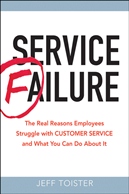The double-edged sword of giving referrals
 Jeff Toister
Jeff Toister  Tuesday, April 27, 2010 at 10:57AM |
Tuesday, April 27, 2010 at 10:57AM |  Referrals are a double-edged sword.
Referrals are a double-edged sword.
Many of us like to refer our friends and family members to businesses and services we enjoy. Asking for referrals from others can make it easier to make a buying decision. Some businesses even offer discounts or other incentives to encourage us to refer.
There's also a potential downside that occurs when the referral doesn't pan out or we discover a friend doesn't share our impeccable taste.
The Bad Experience
It's embarrassing to refer a friend to a trusted person or company only to have that person or company not deliver. Poor service can happen, but it feels a bit personal when you refer someone and they come back to you and say, "Gee, thanks for the crummy referral".
The Crazy Friend
I sometimes find myself questioning a friend after they've had a bad experience with a referral. Secretly, I think "Maybe you are a difficult, needy customer who is impossible to serve." Outwardly, I start feeling defensive and asking if my friend did anything wrong or suggesting my referral may have just had a bad day. The conversation usually concludes with "Well, I've never had that kind of experience before..."
Too Many to Choose
What if you get multiple referrals? If you choose one, do you have to explain yourself so your other friends aren't insulted?
What to do about it
Here are a few ways you can avoid feeling like you are trapped in a Seinfeld episode called "The Referral":
-
Use a consumer rating source like Yelp instead of a friend. Sure, there are a lot of quirky reviewers on Yelp, but at least they're all averaged out. If your friend is quirky, there's just your friend.
-
Have a few criteria in mind. I recently solicited referrals for translation services and received quite a few. It was easy to preserve relationships with the people whose referrals I didn't choose because I could honestly say, "Thanks for the great referral, but the one I chose was a personal friend who was unexpectedly available. I'll definitely keep your referral in mind for future projects."
-
Do some detective work. Find out who your friend uses without asking for a referral directly. Facebook posts, your conversations, and their homes are full of clues about where they shop. Take note, but don't ask so you can avoid the awkwardness. Unlike a good detective, I'd suggest you stop short of diving in your friend's dumpster.
Do you have a good referral story to share? Let's hear it!





